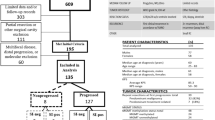Abstract
Background
Many reports on glioblastoma multiforme discuss the prognostic impact of anatomical features such as cysts, necrotic changes, extent of edema or subependymal spread of tumor cells. In the present study, we examined different growth patterns and their possible relations to patient survival.
Methods
To analyze whether anatomical characteristics are related to prognosis, we reviewed the prospectively collected pre- and postoperative MRIs of 83 patients in the 5-ALA study, provided by the 5-ALA Glioma Study Group. Following a standardized analytic work flow, the tumor volume and site, presence of necrosis or cysts, and perifocal edema were assessed preoperatively. In the same way, postoperative MRI and the MRI at first recurrence were analyzed. In addition, survival time of the patients was documented.
Results
Median survival time of all 83 patients was 15.1 months (range 1.5 to 70.1, mean 18). The site or volume of glioblastoma, as well as the presence of intratumoral necrosis or cysts, did not exert a significant effect on survival time; 96.4 % of recurrences occurred within the former resection margin. Tumors with initial contact with the subependymal zone had multifocal or ventricular recurrences significantly more often. In patients with residual tumor on early postoperative MRI, the follow-up images displayed enlargement of the remnants in 91.9 % of these cases.
Conclusions
A merely anatomical analysis of the glioblastoma growth pattern cannot reliably provide prognostic information. The occurrence of most recurrences next to the resection margin and the high percentage of growing residual tumors underline the importance of complete resections.



Similar content being viewed by others
Abbreviations
- ctx+:
-
Tumor tissue is present in the cerebral cortex
- ctx-:
-
Tumor tissue is absent in the cerebral cortex
- GBM:
-
Glioblastoma multiforme
- n.a.:
-
Not applicable
- n.r.:
-
Not reported
- svz+:
-
Tumor tissue is present in the subventricular zone
- svz-:
-
Tumor tissue is absent in the subventricular zone
- T2w-HSC:
-
T2-weighted hyperintense signal change
- p.s.:
-
Present study
- Parts of this article were published as an oral presentation at the meeting of the Neurooncologic Group of the German Society of Neurosurgery (Jahrestagung der Sektion Neuroonkologie der DGNC):
-
Bonn 2009
References
Adeberg S, Bostel T, König L, Welzel T, Debus J, Combs SE (2014) A comparison of long-term survivors and short-term survivors with glioblastoma, subventricular zone involvement: a predictive factor for survival. Radiat Oncol. doi:10.1186/1748-717X-9-95
Bohman LE, Swanson KR, Moore JL, Rockne R, Mandigo C, Hankinson T, Assanah M, Canoll P, Bruce JN (2010) Magnetic resonance imaging characteristics of glioblastoma multiforme: Implications for understanding glioma ontogeny. Neurosurg 67(5):1319–1327
Cage TA, Pekmezci M, Prados M, Berger MS (2013) Subependymal spread of recurrent glioblastoma detected with the intraoperative use of 5-aminolevulinic acid. J Neurosurg 118(6):1220–1223
Chaichana KL, McGirt MJ, Frazier J, Attenello F, Guerrero-Cazares H, Quinones-Hinojosa A (2008) Relationship of glioblastoma multiforme to the lateral ventricles predicts survival following tumor resection. J Neurooncol 89(2):219–224
Ellingson BM, Cloughesy TF, Lai A, Nghiemphu PL, Mischel PS, Pope WB (2011) Quantitative volumetric analysis of conventional MRI response in recurrent glioblastoma treated with bevacizumab. Neuro Oncol 13(4):401–409
Habberstad AH, Lind-Landström T, Sundstrøm S, Torp SH (2012) Primary human glioblastomas - prognostic value of clinical and histopathological parameters. Clin Neuropathol 31(5):361–368
Hayashi Y, Nakada M, Tanaka S, Uchiyama N, Hayashi Y, Kita D, Hamada J (2010) Implication of 5-aminolevulinic acid fluorescence of the ventricular wall for postoperative communicating hydrocephalus associated with cerebrospinal fluid dissemination in patients with glioblastoma multiforme: a report of 7 cases. J Neurosurg 112(5):1015–1019
Hoelscher M, Richter N, Melle C, von Eggeling F, Schaenzer A, Nestler U (2013) SELDI-TOF analysis of glioblastoma cyst fluid is an approach for assessing cellular protein expression. Neurol Res 35(10):993–1001
Iliadis G, Kotoula V, Chatzisotiriou A, Televantou D, Eleftheraki AG, Lambaki S, Misailidou D, Selviaridis P, Fountzilas G (2012) Volumetric and MGMT parameters in glioblastoma patients: Survival analysis. MC Cancer. doi:10.1186/1471-2407-12-3
Kappadakunnel M, Eskin A, Dong J, Nelson SF, Mischel PS, Liau LM, Ngheimphu P, Lai A, Cloughesy TF, Goldin J, Pope WB (2010) Stem cell associated gene expression in glioblastoma multiforme: Relationship to survival and the subventricular zone. J Neurooncol 96(3):359–367
Kimura M, Lee Y, Miller R, Castillo M (2013) Glioblastoma multiforme: Relationship to subventricular zone and recurrence. Neuroradiol J 26(5):542–547
Lim DA, Cha S, Mayo MC, Chen MH, Keles E, van den Berg S, Berger MS (2007) Relationship of glioblastoma multiforme to neural stem cell regions predicts invasive and multifocal tumor phenotype. Neuro Oncol 9(4):424–429
Naeini KM, Pope WB, Cloughesy TF, Harris RJ, Lai A, Eskin A, Chowdhury R, Phillips HS, Nghiemphu PL, Behbahanian Y, Ellingson BM (2013) Identifying the mesenchymal molecular subtype of glioblastoma using quantitative volumetric analysis of anatomic magnetic resonance images. Neuro Oncol 15(5):626–634
Recht L, Jang T, Savarese T, Litofsky NS (2003) Neural stem cells and neuro-oncology: Quo vadis. J Cell Biochem 88:11–19
Stummer W, Pichlmeier U, Meinel T, Wiestler OD, Zanella F, Reulen HJ; ALA-Glioma Study Group (2006) Fluorescence-guided surgery with 5-aminolevulinic acid for resection of malignant glioma: a randomised controlled multicentre phase III trial. Lancet Oncol 7(5):392–401
Tabatabai G, Weller M (2011) Glioblastoma stem cells. Cell Tissue Res 343:459–465
Tejada-Solís S, Aldave-Orzaiz G, Pay-Valverde E, Marigil-Sánchez M, Idoate- Gastearena MA, Díez-Valle R (2012) Prognostic value of ventricular wall fluorescence during 5-aminolevulinic-guided surgery for glioblastoma. Acta Neurochir 154(11):1997–2002
Conflicts of interest
None.
Author information
Authors and Affiliations
Consortia
Corresponding author
Rights and permissions
About this article
Cite this article
Nestler, U., Lutz, K., Pichlmeier, U. et al. Anatomic features of glioblastoma and their potential impact on survival. Acta Neurochir 157, 179–186 (2015). https://doi.org/10.1007/s00701-014-2271-x
Received:
Accepted:
Published:
Issue Date:
DOI: https://doi.org/10.1007/s00701-014-2271-x




